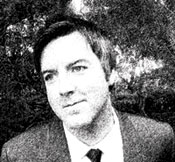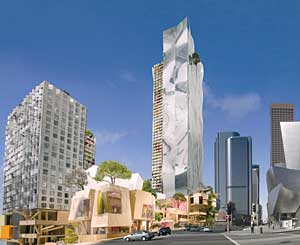Christopher Hawthorne is the architecture critic of the Los Angeles Times.
 Christopher Hawthorne | |
“L.A. IS THE MOST INTERESTING CITY IN THE country right now, because of what’s happening with its urbanism, more than its architecture,” states Christopher Hawthorne, who has been the architecture critic of the Los Angeles Times for three years. The city that became synonymous with sprawl has “hit the limits of its growth and is turning back on itself,” he explains. “But it’s not just getting denser; it’s having to redefine itself as a city.”
This redefinition is affecting everything from mass transit and highways to planning, housing, and architecture, says Hawthorne. “Part of the answer may lie in recapturing the city’s past,” when it had a successful network of streetcars, he suggests. Transit-oriented development is moving forward with projects such as a 1,200- unit housing complex by Arquitectonica wrapping around a plaza above the Wilshire/Vermont Metro station. “It isn’t great architecture,” says Hawthorne, “but it exemplifies a new kind of development for LA.” A mural by the artist April Greiman covers a large part of the Wilshire Boulevard facade, prompting Hawthorne to call the building “the love child of the billboard and the plaza.”

Grand Avenue
In a city notorious for a lack of shared urban spaces, a number of recent projects have included plazas. Renzo Piano’s addition to the Los Angeles County Museum has one, and Rios Clementi Hale designed one adjacent to the Nokia Theater. In the past, the public sector would build these kinds of spaces, but today developers or arts organizations are doing them. Such a trend is part of what Hawthorne calls the growth of “the unprivate city. It’s the opposite of private, but it’s not really public,” he explains.
“L.A. has a long tradition of stand-alone icons, such as the Schindler House, the Getty, Dodger Stadium,” says Hawthorne. “Interestingly, some of the most talked-about recent projects have involved expanding or reimagining buildings that had stood by themselves,” he says, citing Machado and Silvetti’s reworking of the Getty Villa and the expansion of Griffith Observatory by Pfeiffer Partners and Levin & Associates. Asked about Grand Avenue, the large, mixed-use development downtown being designed by Frank Gehry, Hawthorne says, “Gehry’s in the interesting position of extending his beachhead at the Disney Concert Hall and creating an urban context for it.”
Hawthorne worries about the impact of traffic congestion on the city. “People are starting to lead more local, circumscribed lives, because it takes too long to drive to the other side of town. Much of the appeal of L.A. has been having access to the whole area—Malibu, Santa Monica, downtown, Pasadena,” he says. Traffic jams, more planning, and more regulation “may well change the local myth of architectural freedom.” For the past 30 years, architects like Gehry and Thom Mayne have drawn inspiration from industrial construction and the commercial strip, redefining what is ugly and what is beautiful. “We’ve been evaluating architects in Los Angeles on the basis of expressiveness and virtuosity. I don’t know if that’s appropriate anymore.” With the new generation of L.A. architects working on tighter sites where freestanding expressions are less possible, “we may need a new way of thinking about these designers and whether they’re succeeding. Their work may be less loud, less in-your-face.”
Hawthorne also sees L.A. changing directions more literally. Instead of looking east and hiring Richard Meier to design the Getty, for example, he thinks the city is turning south and to Asia.
With Qingyun Ma from China assuming the deanship at USC, Hitoshi Abe from Japan taking over at UCLA, and growing contacts with Latin America, the city’s architectural culture will change, too.




Post a comment to this article
Report Abusive Comment